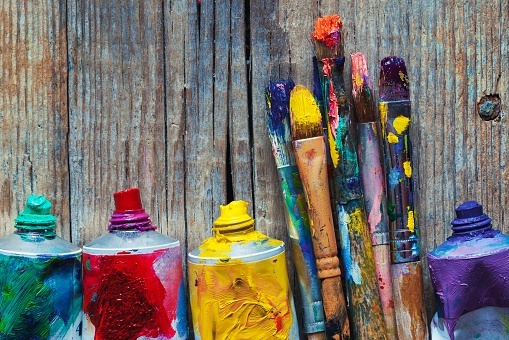It’s Time We Stop Romanticizing the Myth of the Starving Artist

We’ve all heard of “the starving artist” – this person is typically a writer, painter, musician, or performer, who swears by ramen noodles and skipping meals, is plagued with past-due bills and collections notices, and bounces from one friend’s couch to another (or may live out of a car) all in the name of art. It’s a popular trope that we often see in books, movies, theater, and on television. Sometimes these characters are forced to go out and get “real jobs” whereby they end up waiting tables or working a dreadful office job that sucks the life right out of them. Need a refresher?
Hannah Horvath from the HBO series Girls is a twenty-something year old writer who, at the start of the series, works as an unpaid intern at a book publishing company while working on her book. After being cut-off from the financial support of her parents, she moves from one unfulfilling job to the next while struggling to pay her rent and trying to establish her career as a writer.
J.J. Evans from the 70s TV show Good Times is a talented painter growing up in a poor neighborhood, who hopes to use his art to afford a better life for his family. He eventually secures a comic-book deal on the series finale for the character Dyno-Woman that he created, but throughout the series the family struggles to pay the bills and rent, often wondering where their next meal will come from.
The entire cast of the musical RENT. The critically acclaimed musical “tells the story of a group of impoverished young artists struggling to survive and create a life in New York City’s East Village.”
The age old question: Does art imitate life or does life imitate art? We see these characters over and over again in popular culture, and it raises the question whether these romanticized depictions of “starving artists” reinforce certain notions about the value of art and artists.
Independent creators and emerging artists often cite piracy and unfair compensation from streaming platforms as major barriers to success. An article in Forbes entitled “How Online Piracy Hurts Emerging Artists” explains how independent creators in particular are especially vulnerable to the financial harms imposed by piracy. The article quotes Copyright Alliance CEO Keith Kupferschmid, stating:
“Piracy arguably hurts independent creators who are struggling to make it – including photographers, film producers, musicians, and app developers – more than it harms established artists. Independent creators are striving to earn a livelihood and make a career. When they are pirated they lose essential income, they lose confidence, and the lost income prevents them from re-investing in their creative work.”
Couple that with growing trends like Stream Ripping, and studies which suggest that nearly a quarter of all internet traffic is devoted to searching for infringing content, and we get a glimpse into the way society undervalues creators and creative content. On top of that, even certain legitimate uses of copyrighted works often undercompensate artists. For example, songwriters have expressed frustration with the fact that music streaming platforms like Spotify earn billions in revenue, while the writers behind that music earn fractions of a penny per spin. An article in the New Yorker highlights this issue, with a discussion on indie-songwriter Michelle Lewis, who received only $17.72 for her hit song “Wings” which garnered more than 3 million streams on Spotify. And unlike performers, songwriters don’t earn revenue from touring and merchandise sales.
Romanticizing the idea of impoverished artists struggling to create art at the expense of financial security reinforces the notion that artists should create “for the sake of art” alone, with no expectation of compensation, and normalizes the idea that an inability to support one’s self is an inherent part of life as an artist.
For some artists, these financial struggles are very real, and it’s hardly romantic or a badge of honor to wonder whether you’ll eat tonight. J.K. Rowling, for example, described herself as “jobless, a lone parent, and as poor as it is possible to be in modern Britain, without being homeless” while writing the first Harry Potter novel. Other artists like Vincent Van Gogh and Claude Monet lived in poverty, while today their art sells for tens of millions of dollars.
In the article Copyright as a Platform for Artistic and Creative Freedom, Matthew Barblan discusses how copyright affords artists economic freedom, which in turn affords artistic freedom:
“As popular as the “starving artist” cliché may be, real artists need food. Meeting artists’ basic needs goes a long way towards empowering them to create their art. Copyright’s role in giving artists the economic freedom to meet their basic needs—by generating income from their art—is an important part of the relationship between copyright and creative freedom. […] it’s hard for artists to follow their dreams if they don’t know where their next meal will come from or whether they will find somewhere to spend the night indoors. Ultimately, most artists will find a different day job to pay their bills if they can’t make ends meet through their art, thus relegating their art to a hobby.”
Imagine the world without Harry Potter, or a world where names like Vincent Van Gogh or Claude Monet are hardly known because incredibly talented artists stop creating due to financial constraints. Unfortunately, some artists choose to forgo careers in the arts due to issues like piracy which limit their ability to earn income; perhaps your co-worker could have been the artistic voice of our generation, or the teller at your local bank is a musical genius. The reality is that artists don’t starve so that we can enjoy art; they get jobs that pay them enough to eat, and we – the public – lose out. I think it’s time we stop romanticizing the way our society undervalues artists and the art they create.
photo credit: ChamilleWhite/iStock/thinkstock

